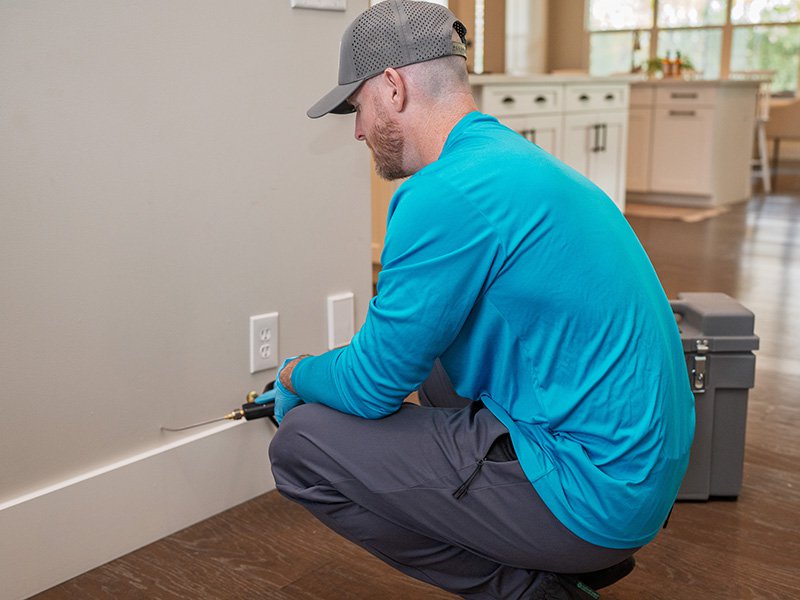What types of termites are in Phoenix, Arizona?
Three main types of termites are commonly found in Phoenix, Arizona:
- Subterranean Termites: Subterranean termites are the most common type of termite in Phoenix. They live in the soil and create mud tubes to access wood above the ground. They are responsible for the majority of termite damage to homes and structures in the area.
- Drywood Termites: Drywood termites live in dry wood and do not require contact with soil. They are typically found in attics, walls, and furniture. If left untreated, this species can cause significant damage to homes and structures.
Dampwood Termites: Dampwood termites are less common in Phoenix than subterranean and drywood termites. They are attracted to wet or damp wood and are typically found in areas with high moisture levels, such as leaky roofs or plumbing. Dampwood termites can damage structures but are less likely to do so than subterranean or dry wood termites.
Signs of termites around your Phoenix home
Termites can be difficult to detect because they often hide inside walls, floors, and other structures. However, there are some signs that can help you recognize the presence of termites in your Phoenix home or property.
- Mud tubes: As we just learned, subterranean termites build mud tubes to travel from their nest to their food source, which is typically wood. These tubes are typically found on the exterior of the home, along the foundation or walls.
- Swarming: Termites swarm in the spring or summer to mate and start new colonies. Swarming termites are attracted to light, so you may notice them around windows, doors, or light fixtures.
- Discarded wings: After swarming, termites will shed their wings. You may notice piles of wings on windowsills, near doors, or in other areas of the home.
- Wood damage: Termites eat wood from the inside out, so wood that appears to be damaged or hollow may be a sign of a termite infestation. You may also notice small holes or tunnels in the wood.
- Clicking sounds: Some species of termites make clicking sounds when they are disturbed. You may hear these sounds coming from walls or other structures.
Common termite myths
Now that we know more about this invasive wood-destroying insect, here are 3 myths that are commonly misunderstood when it comes to this pest:
Myth #1: Termites are only a problem in older homes
One common myth is that termites only infest older homes. However, termites can infest any home, regardless of its age. In fact, many new homes in Phoenix are built with wood frames and are just as susceptible to termite infestations as older homes.
Termites are attracted to wood, but they can also infest other materials like drywall and insulation. If you suspect that your home has a termite problem, it’s important to have it inspected by a professional, regardless of its age.
Myth #2: Termites are only a problem during the spring
Another common myth is that termites only swarm and cause damage during the spring. While it’s true that swarming termites are more common during the spring, termites are active year-round in Phoenix due to the mild climate.
In fact, the warm temperatures in Phoenix can create an ideal environment for termites to thrive no matter the season. It’s important to have regular termite inspections and to take preventative measures year-round to protect your home from termite damage.
Myth #3: DIY termite treatments are effective
Many homeowners believe that they can effectively treat termite infestations on their own using DIY methods, but this is a dangerous myth. DIY termite treatments are often ineffective and can make the problem worse. Common DIY methods homeowners try include cardboard traps, boric acid, orange oil, and heat solutions. While some of these methods can show improvement at the moment, termites will not be exterminated completely using any of these tricks.
Termites are notoriously difficult to eradicate, and DIY treatments can simply push them deeper into your home or spread the infestation to other areas. Professional termite treatments are the most effective way to eliminate termites and prevent future infestations.
Struggling with termites in your home? Contact the professionals at Termio Pest Control
Termites are notorious for being one of the hardest insects to eliminate. Keep in mind that this pest causes over 5 billion dollars of damage to homeowners every year, so if you are dealing with a possible infestation, it’s vital to take care of the issue as soon as possible. Putting your trust in a pest control company can be tiring, so the experts at Termio Pest Control want to deliver solutions that you don’t have to stress about.














